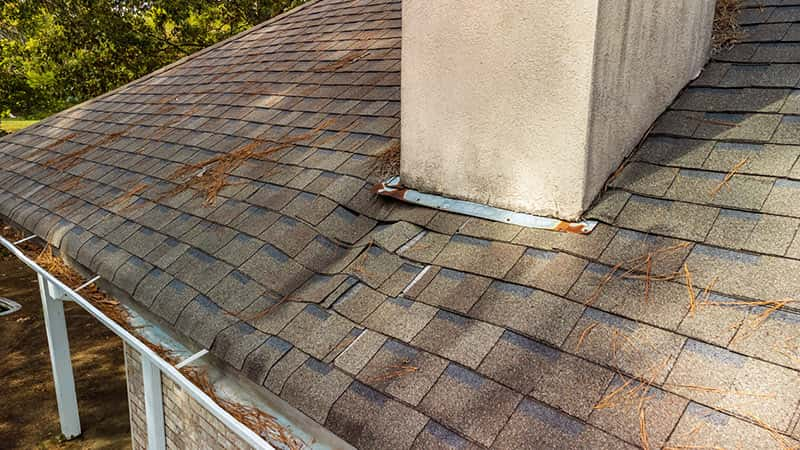You might think that once winter is over, your roof is safe from the elements. You’d be wrong. Just because spring isn’t typically home to snow, hail and freezing temperatures doesn’t mean your roof is perfectly safe.
Here’s a look at some of the most frequent issues that spring weather can bring to your roof:
Gutter Issues
Chances are you put the ladder away once you took down your Christmas lights and hoped you were saying goodbye until the following holiday season. Climbing up there to clean out the gutters isn’t usually anyone’s idea of a fun weekend activity.
However, if you don’t clean those gutters enough, they can clog. Clogged gutters won’t drain properly, which can cause water to collect on your roof and lead to leaks and water damage. Winter can also be detrimental to gutters because of issues like ice buildup, which can weigh down gutters, leading to potential cracks or breaks. All that rain we get in Pacific Northwest springs can continue that damage, leading to all sorts of issues for your home.
Shifted Shingles
Shingles are your home’s initial defense against the outside elements, and they have been known to curl, warp, and crack after chilly temperatures. Once the winter has passed, you should check out the shingles on your roof for any potential damage. A great time to do that is while you’re up there cleaning out the gutters. If you notice any issues, you should have them fixed immediately before a tiny problem balloons into something much larger and more costly.
When the cold hits, the rodents in your area will head out in search of a dry, warm place to nest. If they find any slight damage, crack, or opening in your roof, you might’ve had some houseguests living rent-free throughout the winter, unfortunately.
Pests can damage your roof by nesting and reproducing. They are known to settle in your insulation and damage your wiring, both of which can be costly or just annoying to fix. Among all the spring roof issues you’ll face, pests carry a wide variety of risks and problems with them. Plus, they’re gross.
You and anyone living at your home will want to keep an eye and ear out for any strange noises and droppings, which are pretty clear signs they’ve found a way inside. The pest issue is a two-pronged one. You’ll want to remove them from your home, and then figure out how they got inside so you can fix that. Otherwise, it’s only a matter of time until your guests are back.
Damages or Worn Membranes
The layers underneath your roof’s shingles or tiles are called the membrane. That layer can erode thanks to the drastic changing temperatures and increased moisture that come in the winter. The membrane keeps water out of your home, but if it has been worn down, you’ll most likely experience some damage inside thanks to the heavy rain in the spring.
If you notice leaks inside your home this spring, it could be a sign that part of the membrane has cracked or worn down. If you see a leak inside, you should call the professionals at 4A immediately to inspect. Even slight damage to the membrane can give way for water to get into your home, as well as give rodents access to structural materials and insulation.
Chimney Damage
If you have a chimney and notice some damage to it, chances are it’s from the harsh winter weather instead of a clumsy visit from Santa. In the blistering cold winter months, chimneys can develop cracks that allow water to seep in and cause some deterioration. If the damage is bad enough, a chimney could even collapse and do a ton of damage to your roof.
That damage can spread from the chimney to your shingles and underlayment. As with most issues surrounding the roof, unfortunately, chimney issues can also invite rodents into your home, which can lead to a whole bunch of other problems.
Damage from Trapped Moisture
Spring is a great time for planting, as we see a ton of new growth out in nature. However, there are also likely older leaves and needles trapped on your rooftop from last fall. The combo of new growth and old leaves can leave some matted debris in your gutters and on low-sloping roofs. Those will trap moisture for long periods of time, which you certainly don’t need when trying to keep your home safe.
As plant debris rots, it draws moisture from the air and spreads it through your shingles, which can cause significant amounts of water damage. Moisture can lead to mold growth, leaks, or even sagging rooflines. It’s important to deal with trapped moisture as soon as possible in order to prevent any leaks from forming,
At 4A Roofing, we offer quality workmanship backed by a five-year water-tight warranty and have experience with just about any issue you can have with any and all styles of roofs. Whether you’re in need of a repair up there or a full replacement, we’d be happy to take a look and see what the best option for your home is. Give us a call today at 360-558-1572 for an estimate for your roofing needs.

